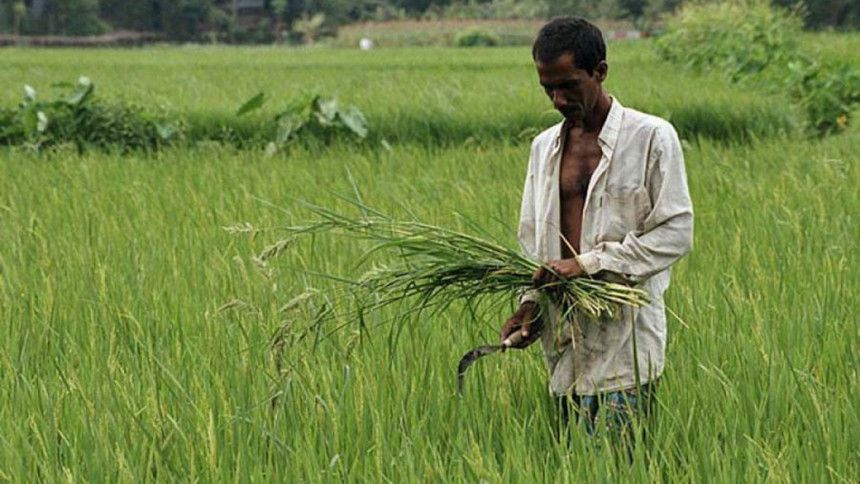Al Amin's HEED
Courtesy: The Daily Star
Ukraine and Russia, known as “the breadbasket of Europe”, are the major exporters of the world’s basic foods. Both countries export approximately one-quarter of wheat, more than three-quarters of sunflower oil and one-sixth of corn.
From the beginning of the war on February 24, 2022, now in the third month, the invasion of Ukraine has caused food price inflation following the economic downturn sparked by the Covid-19 pandemic. Disruption in international trade has affected mostly the import-oriented countries in Asia, the Middle East and Africa. The war will have a ripple effect, which leads to “cascading risk”.
How the war will trigger Bangladesh’s food crisis
The Ukraine war has already created a shock in the commodity market of Bangladesh. The supply chain disruption in the international market caused a price hike in soybean oil in Bangladesh, although the country imports soybean oil mainly from the United States, Brazil and Canada.
The price of wheat flour increased sharply as Bangladesh imports wheat mainly from the Black Sea region. According to the Observatory of Economic Complexity (OEC), more than half of wheat was imported from those two countries.
For instance, in 2020, Bangladesh imported $1.28 billion-worth wheat, which was the top import (2.65 per cent) among the traded foodstuffs. The highest share was imported from Russia (31.8 per cent) worth $409 million and Ukraine (23 per cent) worth $295 million.
Similarly, in 2020 a significant portion of dried legumes, corn, onion, rapeseed, and apples and pears was imported from those countries.
Fertiliser prices surged owing to the conflict. Russia and Belarus provide approximately 40 per cent of the world’s potash. The soaring price of fertiliser could lead to serious problems for Bangladesh’s arable farming.
Owing to high worldwide petroleum prices linked to the Ukraine invasion, the country already feels the increasing pressure of diesel prices. This price increase may spark the uncertainty of the government’s transitional policy toward conventional mechanisation since, to date, there is no cost-effective substitute for diesel engines.
The high import dependency means that the Bangladesh economy is feeling the heat of the Ukraine war that may trigger the food crisis in Bangladesh. The extent of impacts may last even after the war. The Ukraine war could be a wake-up call for Bangladesh’s arable sector.
Ways forward to Bangladesh’s forward arable sector
From birth to the first three decades, the prime objective of the political economy of Bangladesh was to ensure “food security”. However, in the last two decades, Bangladesh extended the focus to “food and nutrition security” prioritising crop diversification.
To achieve the vision of the Ministry of Agriculture (i.e., safe, profitable and sustainable agriculture), the Bangladesh government developed several policies such as the National Agriculture Policy 2018 and the National Agricultural Mechanisation Policy 2020.
Considering the prevailing problems of Bangladesh’s subsistence agriculture, with economic shocks from the Covid-19 pandemic and the Ukraine war, Bangladesh needs an evolutionary policy instead of a revolutionary policy. To achieve the goals of the arable sector, Bangladesh should consider the following seventh-fold prescriptions:
First, to overcome the food crisis, Bangladesh should ensure the immediate import of wheat, corn and soybeans to fulfil the national demands at reasonable prices. The government support systems based on income class should be strengthened and extended.
Second, in the next growing seasons to reduce import dependency on commodity crops, the government should promote diversification, incorporating wheat, corn and oilseed production. To make this diversification successful, agricultural research, education and extension organisations should help farmers identify which crops and production practices will be practical and profitable on their farms.
In the short run, the government can assist with output market stabilisation and subsidies for fertiliser, fuel and other inputs, but in the long run, the crop choices for diversification should be able to stand on their own.
Third, conventional agricultural mechanisation may not bring a paradigm shift in the booming overall economy owing to agricultural labour scarcity, younger generations’ negative feelings about agriculture, requiring farm consolidation and exacerbation of the environmental footprint of agriculture. Consequently, the government should avoid the downsides of conventional agriculture by skipping a few steps to increase land productivity with precision agriculture within the current farming landscape of small field sizes, trees along field edges, and rural villages.
Fourth, the arable sector needs farm management analysis with different equipment options and cropping patterns. The analysis should go beyond rice monoculture to consider crop rotations with polyculture, catch crops, and relay, strip or patch intercropping to achieve social, economic and environmental sustainability.
Fifth, agricultural policies should protect the interest of the smallholders by exploring size-neutral farm productivity innovations including digital apps for farm equipment contracting and sharing, as well as electrically powered autonomous machines. This would simultaneously open entry windows for the younger generation with potential for “farming as a service” contracting and machine hire businesses and opportunities in the agricultural robotics industry with a potential worldwide market.
Sixth, the arable sector should move from production-centric to market-centric infrastructure with digital innovation. Smallholders and young entrepreneurs could use mobile phones, internet and social media for marketing those diversified farm products.
Seventh, universities and research organisations should be the hub of innovation with the support of the government and industries, where industries could avoid fixed costs of research and academics could apply theoretical knowledge. One of the side effects of this approach is that academics with practical experience would be better teachers.
In summary, Bangladesh should embrace Industry 4.0, specifically, Agriculture 4.0. In this process, retrofitting existing machinery, supporting new digital technologies and promoting home industries and startups could be potential sustainable intensification solutions.
The authors are, respectively, an Elizabeth Creak Fellow at Harper Adams University of the UK, the Elizabeth Creak Chair in Agri-Tech Applied Economics at the university, and a professor of agricultural economics at the Bangladesh Agricultural University

